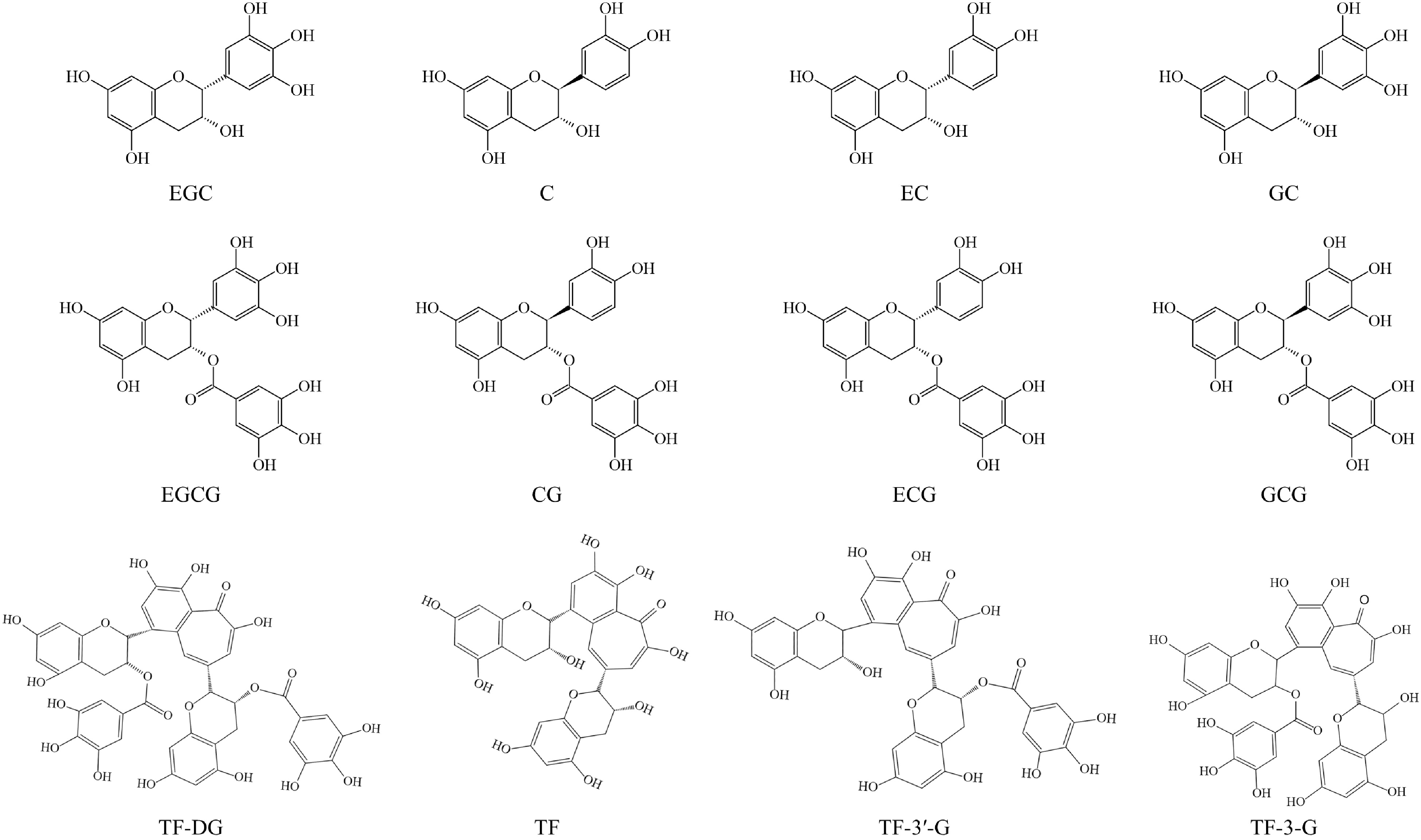-

Figure 1.
Chemical structures of the primary polyphenols in tea.
-

Figure 2.
The mechanisms of tea bioactive components (tea polyphenols, polysaccharides, and alkaloids) help prevent and treat DM and its complications (image source from Freepik.com).
-
Categories of hypoglycemic medicines Common clinical drugs Hypoglycemic mechanisms Adverse effects Insulin Insulin Enhance glucose uptake and utilization by systemic tissues and cells while inhibiting glycogenolysis and glycogen isogenesis. Hypersensitivity, lipodystrophy, and lipohypertrophy Thiazolidinediones Rosiglitazone; Pioglitazone Increase insulin sensitivity in liver, muscle, and adipose tissue. Abnormal liver function and weight gain Biguanides Pioglitazone; Buformin; Metformin Inhibit hepatic glucose output, improve the insulin sensitivity of peripheral tissues, and increase glucose uptake and utilization. Loss of appetite, nausea, abdominal discomfort, and diarrhea Sulfonylureas Glimepiride; Gliquidone; Gliclazide; Glipizide Reduce blood glucose levels by stimulating β-cells insulin secretion. Hypoglycemic reaction, loss of appetite, nausea and vomiting, diarrhea, and increased risk of cardiovascular disease Dipeptidyl peptidase-4
(DPP-4) inhibitorsLinagliptin; Saxagliptin; Vigliptin Reduce glucagon and hypoglycemia. Nasopharyngitis, headache, and upper respiratory tract infection Glucagon-like peptide 1
(GLP-1) receptor agonistLixisenatide; Albiglutide; Dulaglutide; Semaglutide Reduce blood glucose levels by increasing insulin secretion and inhibiting postprandial glucagon secretion. Nausea, vomiting, diarrhea, injection-site inflammation, and pancreatitis α-Glucosidase inhibitors Acrobose; Miglitol; Voglibose Hinder the decomposition and absorption
of dietary carbohydrates by inhibiting pancreatic α-amylase and intestinal α-glucosidase.Gastric flatulence and diarrhea Sodium-glucose-cotransporter type-2 (SGLT-2) inhibitors Canagliflozin; Ertugliflozin; Dapagliflozin; Empagliflozin Inhibit glucose reabsorption in the kidney and eliminate glucose from the urine. Urinary tract infection Table 1.
Summary of the categories of hypoglycemic medicines, common clinical drugs, hypoglycemic mechanisms, and adverse effects.
-
Tea/bioactive components Animal models Doses (day) Duration (weeks) Effects and mechanisms Ref. Yellow tea extract C57BL/6J mice 60 or 120 mg/kg 10 Improves impaired glucose tolerance, pyruvate tolerance, and insulin resistance. [45] Black tea extract Wistar rats 25, 50, or 100 mg/kg 30 d Decreases the level of glucose, glycated hemoglobin and increases the levels of insulin. [47] White tea extract Wistar rats / 8 Improves glucose tolerance and insulin sensitivity. [48] Pu-erh tea extract Wistar rats 120, 160, 600, or
800 mg/kg6 Increases the abundance of the beneficial bacteria. [49] Fu brick tea extract C57BL/6J mice 100, 200, or
400 mg/kg8 Ameliorates the T2DM-induced gut dysbiosis by decreasing the Firmicutes/Bacteroidota ratio at the phylum level. [50] Liubao tea extract C57BL/6J mice 834 or 1,667 mg/kg 10 Increases the diversity of intestinal flora. [51] Tea polyphenols Wistar rats 200 mg/kg 6 Improves insulin sensitivity and decreases the inflammatory factors. [55] Kaempferol Sprague–Dawley rats 50 or 150 mg/kg 10 Enhances insulin sensitivity. [56] Theaflavins Spontaneously diabetic torii rats 25 mg/kg 20 Improves impaired glucose tolerance. [57] Tea polysaccharides ICR mice 150, 200, or 300 mg/kg 4 Improves insulin resistance. [60] EGCG; Epiafzelechin-3-gallate; ECG / / / Exhibits inhibitory effects against α-glucosidase. [64] Oolong tea polyphenols; EGCG; EGCG3″Me / / / Exhibits inhibitory effects against α-amylase. [67] Quercetin-3-O-(6″-O-galloyl)-β-galactopyranoside; Quercetin-3-O-(3″-O-galloyl)-β-glucopyranoside / / / Exhibits inhibitory effects against α-glucosidase. [68] Tea polysaccharides ICR mice 1 or 5 mg/kg / Exhibits inhibitory effects against α-glucosidase. [69] Tea polysaccharides ICR mice 50 mg/kg / Exhibits inhibitory effects against α-glucosidase. [70] Tea polysaccharides / / / Exhibits inhibitory effects against α-amylase and α-glucosidase. [71] Tea polysaccharides / / / Exhibits inhibitory effects against α-glucosidase. [72] Tea polysaccharides C57BL/6 mice 200, 400, or
800 mg/kg8 Increases the phylogenetic diversity of HFD-induced microbiota. [76] EGCG Db/db mice 10, 50, or 100 mg/kg 8 Increases the abundance of beneficial bacteria. [78] Tea polysaccharides Wistar rats 100, 200, or
400 mg/kg/ Modulates gut microbiota diversity and increases the abundance of beneficial genera. [79] Quercetin Wistar rats 50 mg/kg 3 Exhibits anti-inflammatory activity. [82] Caffeine KK-Ay mice 250 mg/L 5 Reduces inflammatory cytokine expression (TNFα, IL-6, and MCP-1). [83] EGCG Db/db mice 2.5, 5.0, or 10.0 g/kg 7 Decreases the PEPCK mRNA expression in the adipose and liver tissues. [87] Tea polyphenols Wistar rats 200 mg/kg 6 Upregulates the insulin signaling protein levels. [55] Tea polysaccharides Kunming mice 200, 400, or
800 mg/kg4 Upregulates the expressions of the critical proteins in the PI3K/Akt signal pathway including GLUT4, p-Akt, and PI3K. [90] Tea polyphenols; Tea polysaccharides; Caffeine Sprague–Dawley rats 400 or 800 mg/kg 6 Reduces rat serum leptin levels, inhibits the absorption of fatty acids, and reduces the expression levels of the IL-6 and
TNF-α genes.[91] EC Sprague–Dawley rats 50 or 100 mg/kg 2 Improves advanced glycation end products-induced retinal vascular injury. [94] Table 2.
The effects and mechanisms of tea and its bioactive components on DM based on in vitro and in vivo studies
Figures
(2)
Tables
(2)